Meniscus tears are among the most common knee injuries in sports, especially in ball sports such as soccer. The meniscus can tear if the knee is twisted under heavy load. Meniscus tears as a result of acute injuries occur especially in younger people. They are usually operated at singapore orthopaedic surgery on, but can sometimes be treated conservatively with strengthening exercises, painkillers and bandages. Which treatment is suitable depends on the size and type of the crack and the symptoms.
Important to know: In the case of wear-related degenerative meniscus tears, an operation is usually not useful. Many people experience them in the course of their lives, but most do not even notice them. Meniscus damage caused by wear and tear is particularly common in people with knee osteoarthritis . Here it is crucial to exercise the knee regularly and to treat the knee osteoarthritis well.
Acute, injury-related meniscus tears are manifested by pain, especially when the knee is twisted and bent. The knee can also swell. Some people hear a popping or clicking sound when the meniscus tears. The symptoms that arise depend on the shape and size of the meniscus tear.

Smaller meniscus tears are not always immediately noticeable. The pain often takes a few hours or days to develop. Some people take a few weeks to realize that their knee is injured. You will then feel an out-of-round movement when you bend and straighten your knee.
Larger meniscus tears are often more painful and cause the knee to swell. In addition, they can interfere with or restrict knee movements – as if the knee is “stuck”. If part of the meniscus tears off, it can block the knee. Then it can no longer be fully extended.
Age-related changes or tears in the menisci rarely cause symptoms. Around 20% of people over 40 years of age have meniscus tears or damage, which can be seen during examinations but do not cause any symptoms. Worn menisci are even more common in people with knee osteoarthritis: Around 60% of people with knee osteoarthritis visible on X-rays have meniscus changes or tears.
Age-related meniscus damage is rarely the cause of knee pain. Meniscus surgery is therefore usually not useful in the case of degenerative meniscus damage.The menisci are two crescent-shaped cartilage discs between the lower and upper thigh bones. The inner meniscus is on the inside and the outside meniscus is on the outside of the knee . Both menisci stabilize the movements of the knee joint, distribute the pressure and cushion shocks. They also lubricate the joint cartilage and supply it with nutrients.



